Table of Contents
- Introduction
- Editor’s Choice
- Burden of Epilepsy
- Worldwide Epileptics Statistics
- Epidemiology of Epilepsy
- Epilepsy Monitoring Devices Market Overview
- Epilepsy Treatment Market Overview
- Popular Antiepileptic Drugs Statistics
- Clinical Trials for Epilepsy
- Effectiveness of Epilepsy Medications
- Cost of Epilepsy Medications
- Initiatives for the Development of Anti Epilepsy Medications
- Investments in the Development of Anti Epilepsy Medications
- Research for Anti Epilepsy Medications and Treatments
- Initiatives to Raise Awareness Against Epilepsy
- Regulations for Anti Epilepsy Medications and Treatments
Introduction
According to Epileptics Statistics, Epilepsy, a neurological disorder, manifests through recurrent seizures caused by abnormal brain activity. These seizures vary from partial, affecting specific body parts, to generalized, involving the entire body.
Causes include brain injuries, genetic factors, infections, and developmental issues. Diagnosis involves medical history, physical exams, EEG tests, and imaging.
Treatment includes antiepileptic drugs, surgery for severe cases, and lifestyle adjustments such as stress management and regular sleep.
Ongoing research aims to enhance treatments and understanding of epilepsy’s mechanisms, improving outcomes and quality of life for those affected.
Editor’s Choice
- South Asia had the highest number of epilepsy cases at 5,272,409 in 2016.
- As of 2015, the number of active cases in the United States varied across different age groups. There were 803,000 cases among individuals aged 18-34 years.
- Focal seizures, particularly focal impaired awareness seizures, are the most common seizure type across all age groups, comprising about 36% of all seizure cases.
- The global epilepsy monitoring devices market revenue is expected to reach USD 7.4 billion by 2033.
- In 2023, the global treatment market revenue was valued at USD 6.5 billion.
- In 2023, the leading antiepileptic drugs dispensed in England were dominated by Pregabalin, with 9,083,461 items dispensed.
- In 2024, the UK government announced a £45 million investment in research for epilepsy, cancer, and dementia, which aims to accelerate the development of new treatments.
Burden of Epilepsy
- In 2016, epilepsy posed a significant global health challenge, affecting approximately 46 million people worldwide.
- Nearly 80% of these cases were concentrated in low- and middle-income countries (LMICs), where both prevalence and incidence rates are notably higher than in high-income countries (HICs).
- This disparity is attributed to various factors, such as different underlying causes, increased rates of injuries, and limited access to healthcare services.
- Epilepsy accounted for more than 13 million Disability Adjusted Life Years (DALYs) in 2016, constituting 0.5% of the total disease burden globally.
- Across different regions, epilepsy ranked between second and eighth in terms of age-standardized DALY rates among all neurological disorders.
Worldwide Epileptics Statistics
Global Epilepsy Prevalence Rates
- A systematic review and meta-analysis indicated that epilepsy had an incidence rate of 61.4 per 100,000 person-years.
- Incidence rates were significantly higher in low/middle-income countries (LMIC) at 139.0 compared to 48.9 in high-income countries (HIC).
- The overall lifetime prevalence was 7.60 per 1,000 populations, with LMIC reporting higher rates than HIC.
- The point prevalence of active was 6.38 per 1,000, with median rates in LMIC at 6.68 and in HIC at 5.49.
Number of Epilepsy Cases – By Region
- In 2016, the number of epilepsy cases varied significantly across different regions.
- High-income North America reported 1,266,669 cases, while Australasia had 65,797 cases.
- The high-income Asia-Pacific region recorded 364,894 cases, and Western Europe had 1,525,168 cases.
- In Southern Latin America, there were 184,053 cases, whereas Eastern Europe and Central Europe reported 431,632 and 358,718 cases, respectively.
- Central Asia saw 350,725 cases, and Central Latin America had 361,130 cases.
- Andrean Latin America recorded 261,097 cases, with the Caribbean at 136,726 cases and Tropical Latin America at 848,153 cases.
- East Asia had a substantial number of cases at 3,393,239, while Southeast Asia reported 2,476,546 cases.
- Oceania had 26,404 cases, and the North Africa & Middle East region recorded 2,085,190 cases.
- South Asia had the highest number of cases at 5,272,409.
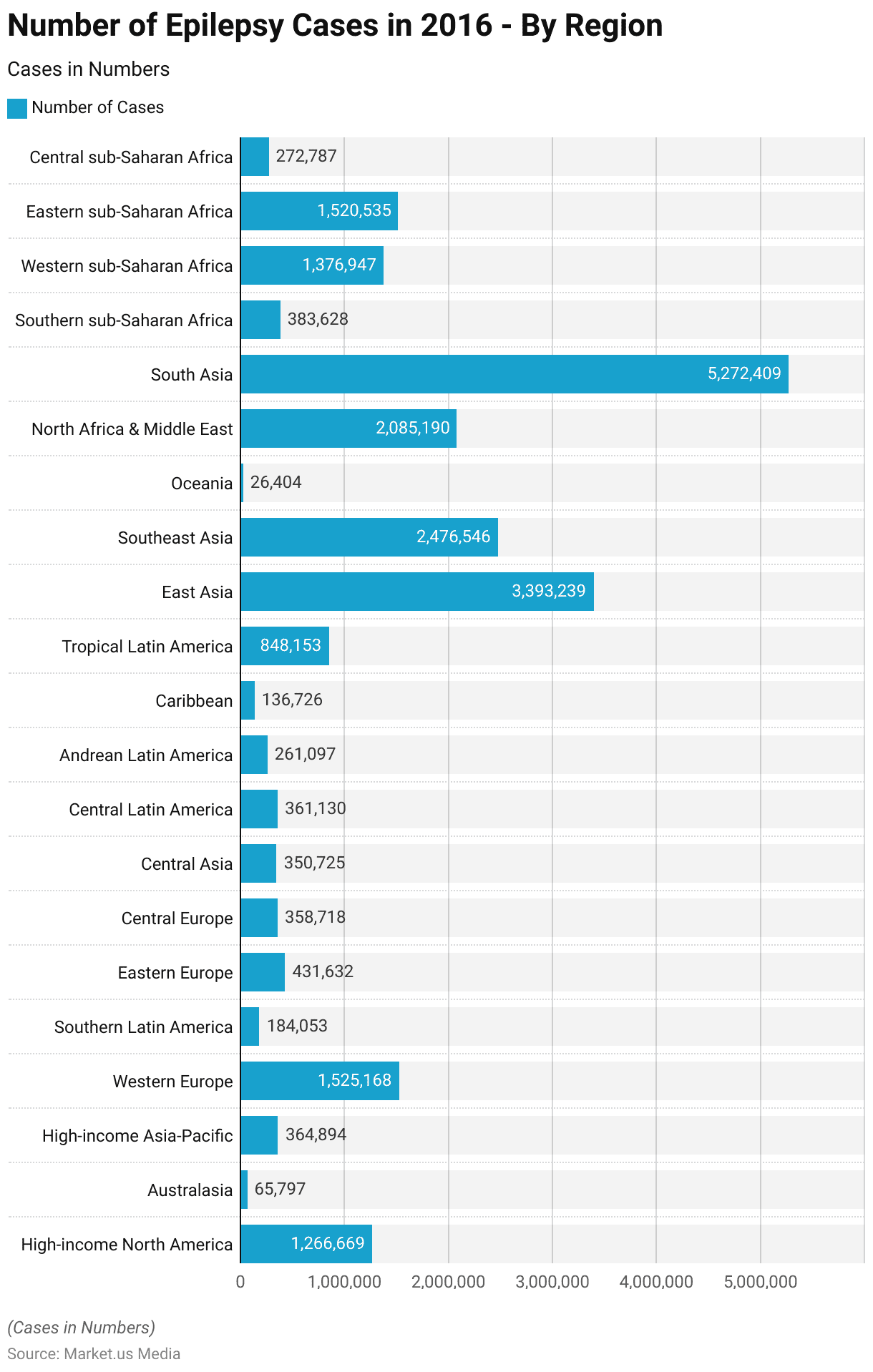
Number of Epilepsy Cases – By Country
- In 2016, the number of epilepsy cases varied widely among different countries.
- India reported the highest number, with 3,934,737 cases, followed by China with 3,261,138 cases.
- The United States recorded 1,181,207 cases, while Brazil had 825,349 cases, and Mexico reported 727,028 cases.
- Pakistan had 690,645 cases, and Nigeria reported 577,948 cases.
- In Germany, there were 429,396 cases, while Egypt had 347,306 cases.
- France recorded 304,489 cases, and South Africa had 294,658 cases.
- Russia reported 288,899 cases, and Thailand had 279,933 cases.
- Japan recorded 247,249 cases, while the United Kingdom had 221,727 cases.
- Italy reported 163,995 cases, and South Korea had 107,821 cases.
- Spain recorded 105,520 cases, Canada had 84,838 cases, and Australia reported 55,674 cases.
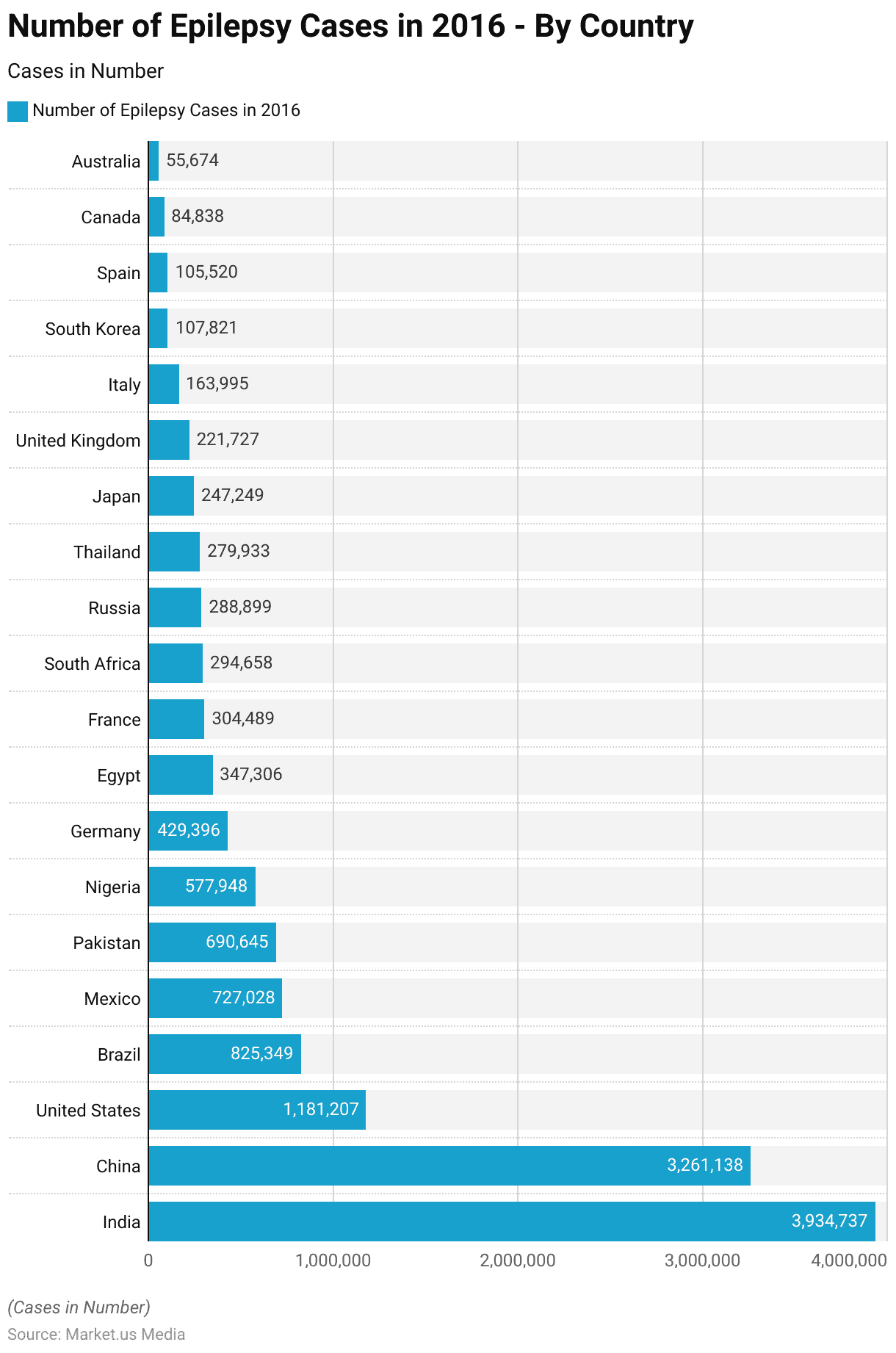
Deaths Due to Epilepsy
Number of Deaths Due to Epilepsy – By Country
- In 2016, the number of deaths due to varied significantly across different countries.
- India reported the highest number, with 34,253 deaths, followed by China with 12,779 deaths.
- South Africa recorded 4,429 deaths, while Nigeria had 3,772 deaths, and Pakistan reported 3,580 deaths.
- Brazil had 2,495 deaths, Germany recorded 2,308 deaths, and the United States reported 2,076 deaths.
- Mexico had 1,989 deaths, and France reported 1,703 deaths.
- The United Kingdom recorded 1,123 deaths, while Russia had 882 deaths, and Italy reported 730 deaths.
- Thailand recorded 693 deaths, Japan had 681 deaths, and South Korea reported 535 deaths.
- Egypt had 498 deaths, while Spain recorded 452 deaths, Canada reported 314 deaths, and Australia had 293 deaths.

Epidemiology of Epilepsy
Incidence and Prevalence of Epilepsy – By Sex and Age
- Epilepsy is most prevalent among the youngest and oldest age brackets, with an estimated annual incidence of 86 per 100,000 in infants, gradually decreasing to 23–31 per 100,000 among individuals aged 30–59 years and then rising again to 180 per 100,000 in those over 85 years old.
- Among children, epilepsy is most common during infancy and declines to levels typical of adults by age 10.
Prevalence and Incidence of Epilepsy – By Seizure Type
- Focal seizures, particularly focal impaired awareness seizures, are the most common seizure type across all age groups, comprising about 36% of all seizure cases.
- However, in many low- and middle-income countries (LMICs), generalized tonic-clonic seizures are frequently reported due to under-recognition and limited diagnostic resources for other seizure types.
- Status epilepticus (SE) shows varying annual incidences ranging from 6.8 to 41 per 100,000, with peaks observed in children under one year old and elderly individuals, reflecting differences in population characteristics, diagnostic accuracy, underlying causes, and criteria for inclusion of acute symptomatic seizures.
Incidence and Prevalence – By Epilepsy Type
- In a study conducted two decades ago among a US population, focal epilepsies of unknown cause were the most prevalent among newly diagnosed cases (17.5 cases per 100,000 annually), followed closely by symptomatic partial epilepsies (17.2), and epilepsies of unknown origin (9.7).
- Symptomatic or cryptogenic epilepsies accounted for 4.0 cases, idiopathic generalized epilepsies for 3.7, and idiopathic partial epilepsies for 0.2.
- The proportion of epilepsies with unknown causes has remained largely unchanged in recent years, especially in high-income countries (HIC).
Epilepsy Monitoring Devices Market Overview
Global Epilepsy Monitoring Devices Market Size
- The global epilepsy monitoring devices market has shown a steady growth trajectory from 2023 to 2033 at a CAGR of 6.0%.
- In 2023, the market was valued at USD 4.2 billion, projected to grow to USD 4.4 billion in 2024.
- The upward trend continues, with the market reaching USD 6.5 billion in 2031, USD 6.9 billion in 2032, and USD 7.4 billion by 2033.
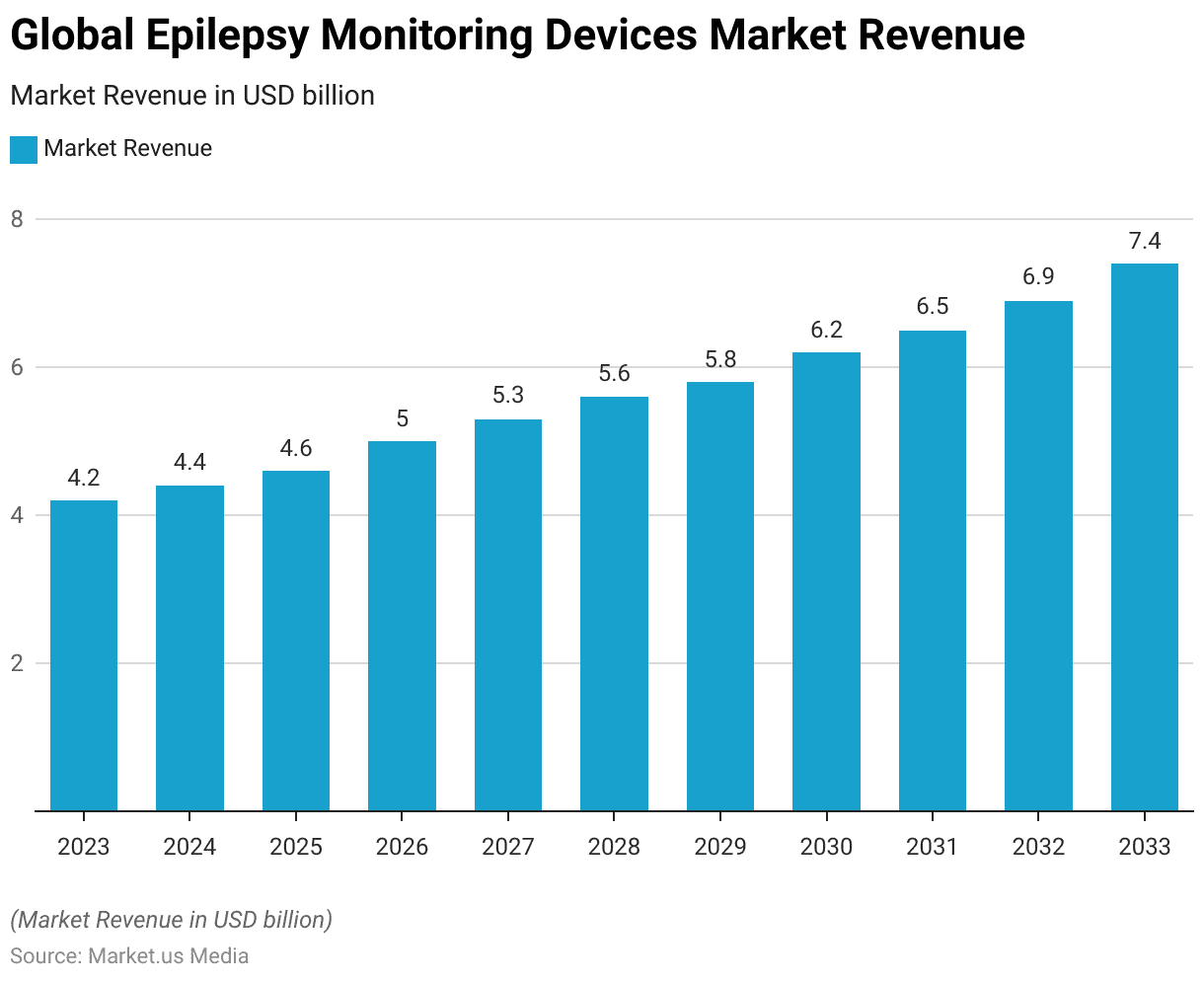
Global Epilepsy Monitoring Devices Market Size – By Product Type
- The global epilepsy monitoring devices market, segmented by product type, demonstrates notable growth from 2023 to 2033.
- In 2023, the total market size was USD 4.2 billion, with conventional devices accounting for USD 2.07 billion and wearable devices contributing USD 2.13 billion.
- Finally, in 2033, the market size was USD 7.4 billion, with conventional devices contributing USD 3.65 billion and wearable devices USD 3.75 billion.

Epilepsy Treatment Market Overview
Global Epilepsy Treatment Market Size
- The global epilepsy treatment market has experienced consistent growth from 2023 to 2033 at a CAGR of 7.7%.
- In 2023, the market was valued at USD 6.5 billion, rising to USD 7.0 billion in 2024.
- The growth trajectory persisted, with the market reaching USD 11.4 billion in 2031 and USD 12.3 billion in 2032, culminating at USD 13.4 billion by 2033.
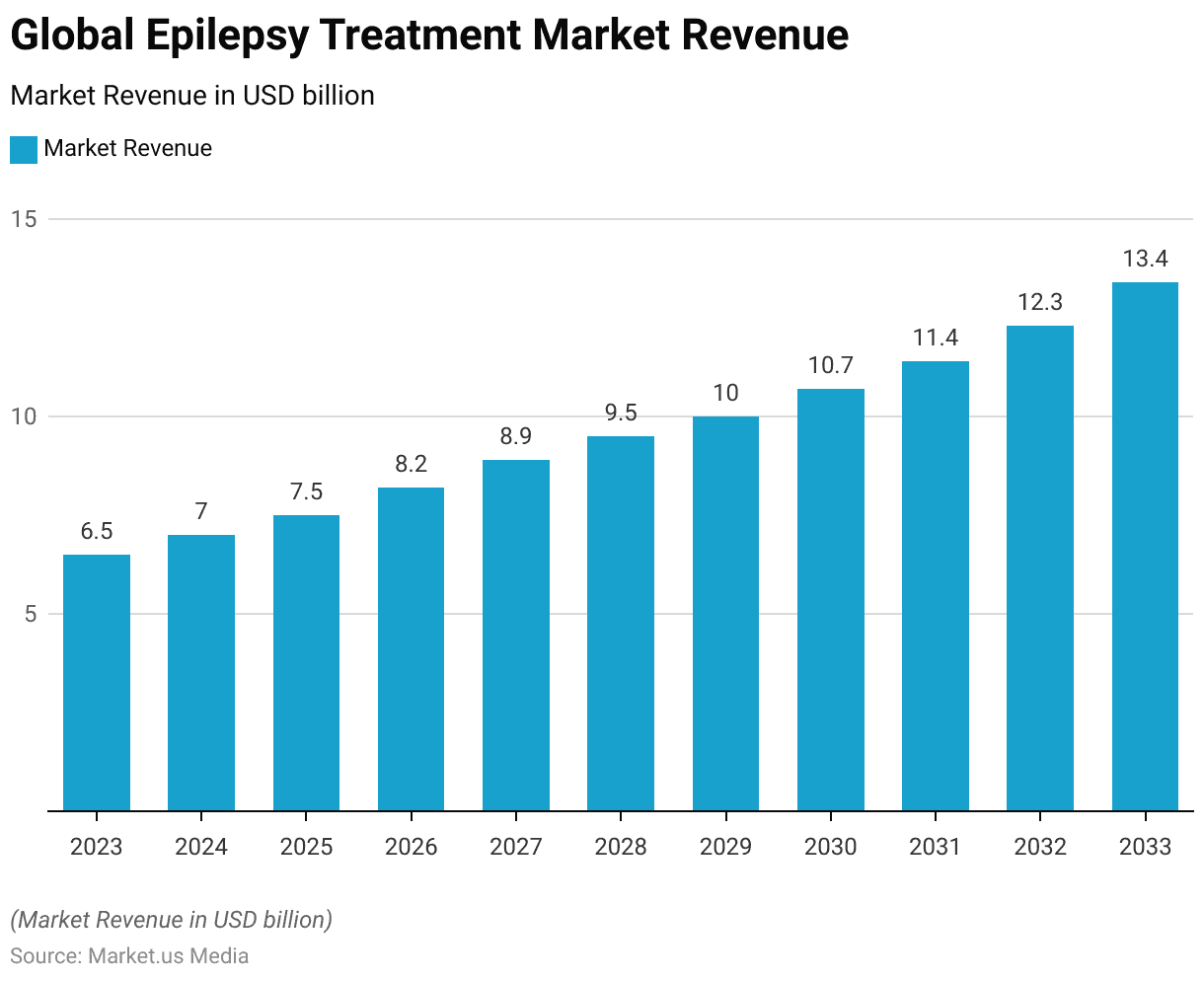
Popular Antiepileptic Drugs Statistics
Leading Antiepileptic Drugs Dispensed
- In 2023, the leading antiepileptic drugs dispensed in England were dominated by Pregabalin, with 9,083,461 items dispensed.
- Gabapentin followed closely with 7,414,922 items.
- Lamotrigine was the third most dispensed drug, with 3,778,063 items, while Levetiracetam accounted for 2,973,628 items.
- Sodium valproate was dispensed 2,311,110 times, and Carbamazepine followed with 2,095,164 items.
- Topiramate had 1,172,160 items dispensed, and Clonazepam accounted for 1,058,827 items.
- Phenytoin sodium and Clonazepam rounded out the list, with 513,659 and 386,265 items dispensed, respectively.
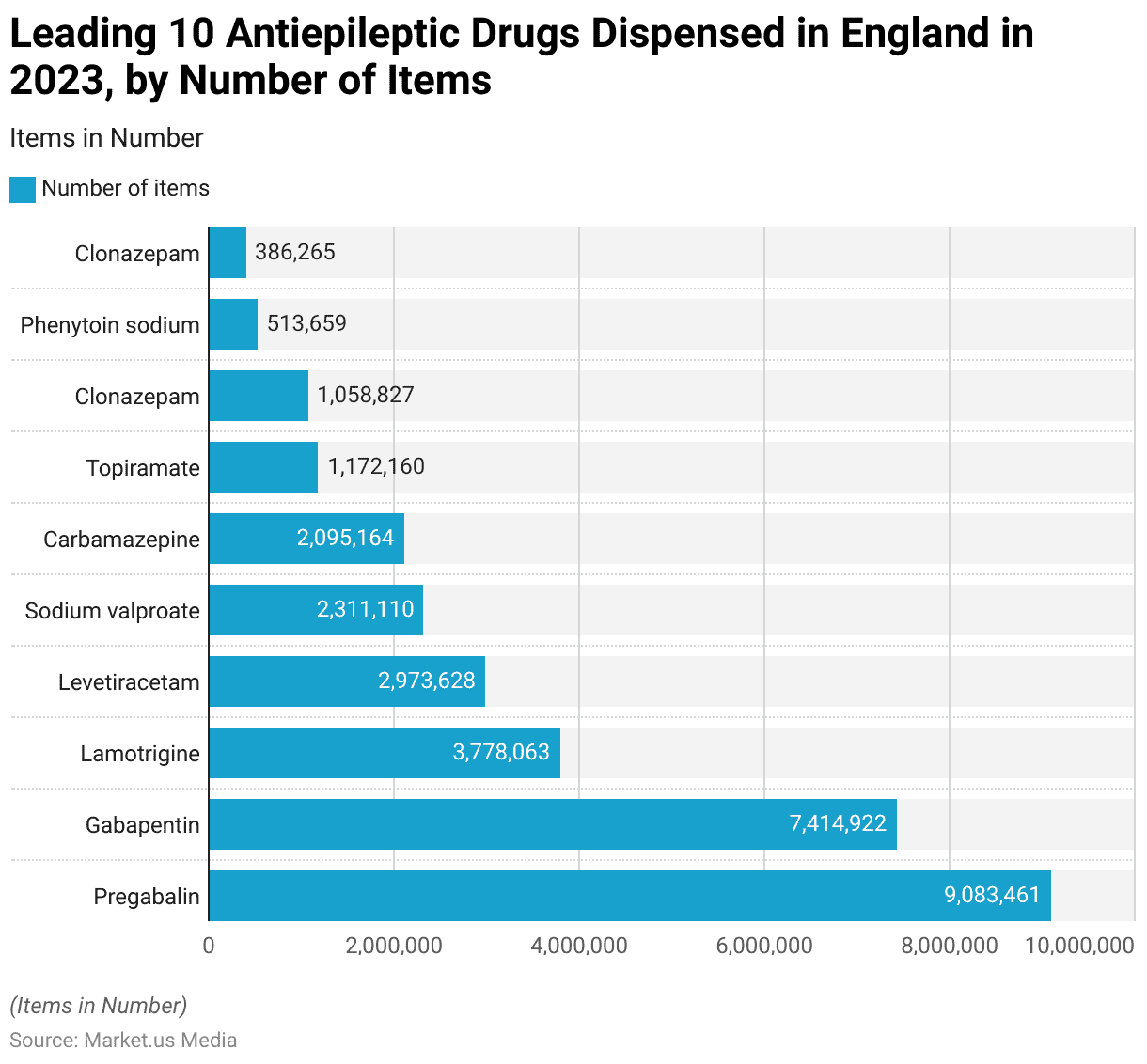
Clinical Trials for Epilepsy
- As of April 27, 2023, the clinical landscape for treatment is marked by a substantial number of ongoing trials across various phases.
- There are currently 17 trials in the Early Phase 1 stage, with an additional 157 trials in Phase 1.
- The number of trials increases in the subsequent phases, with 275 trials in Phase 2 and 327 trials in Phase 3.
- In the final phase, Phase 4, there are 145 trials.
- Additionally, 469 trials are classified as not applicable to the standard phase categorization.
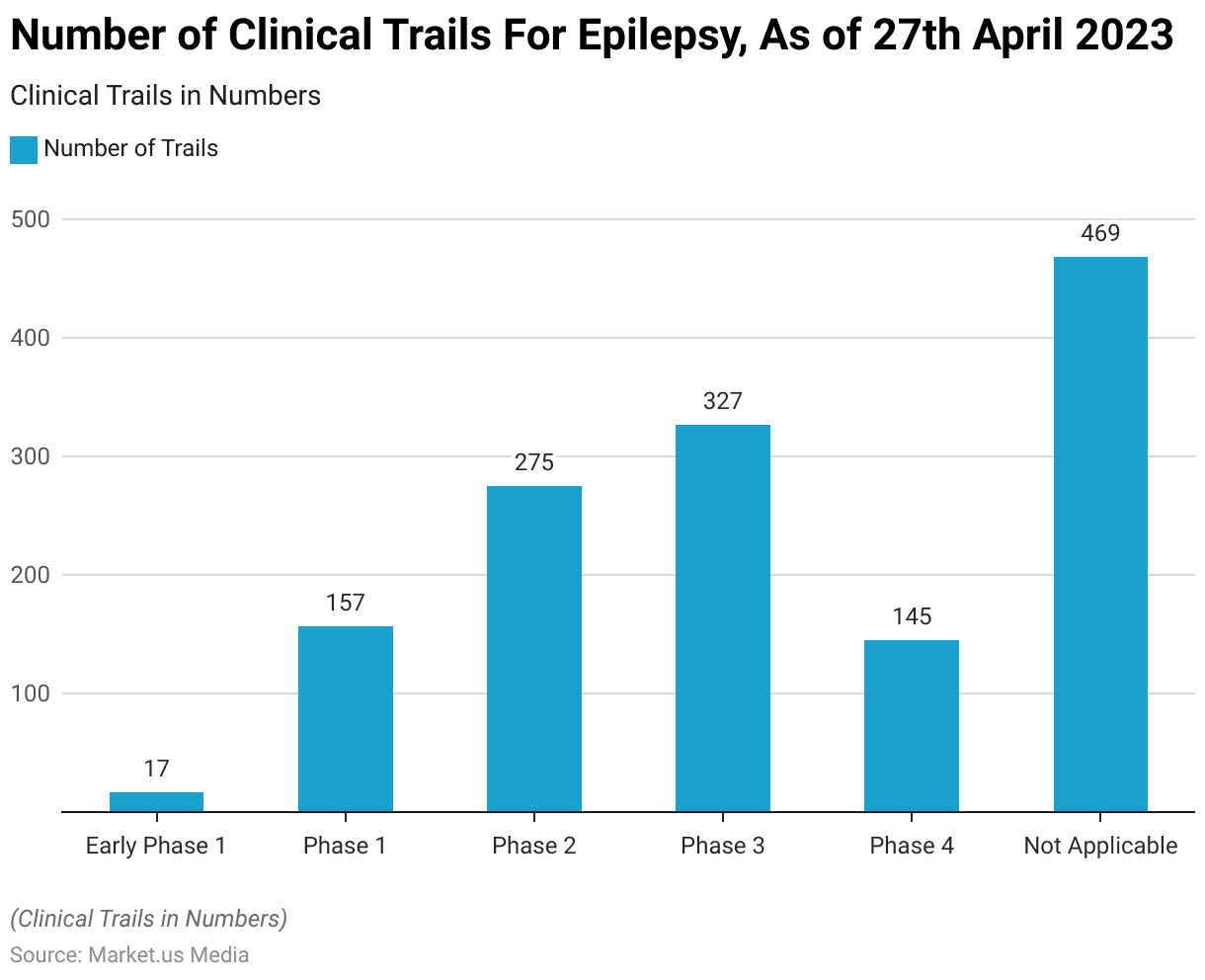
Effectiveness of Epilepsy Medications
According to Age
- As of 2015, the effectiveness of epilepsy medication in achieving seizure-free status among U.S. adults varied significantly across different age groups.
- Among adults aged 18 to 34 years, 42.30% reported becoming seizure-free with epilepsy medication.
- In the age group of 35 to 54 years, 36.90% of individuals experienced seizure freedom.
- A slightly higher success rate was observed in adults aged 55 to 64 years, with 43.70% achieving seizure-free status.
- The highest percentage was seen in individuals older than 65 years, where 62.70% of patients with epilepsy became seizure-free with medication.
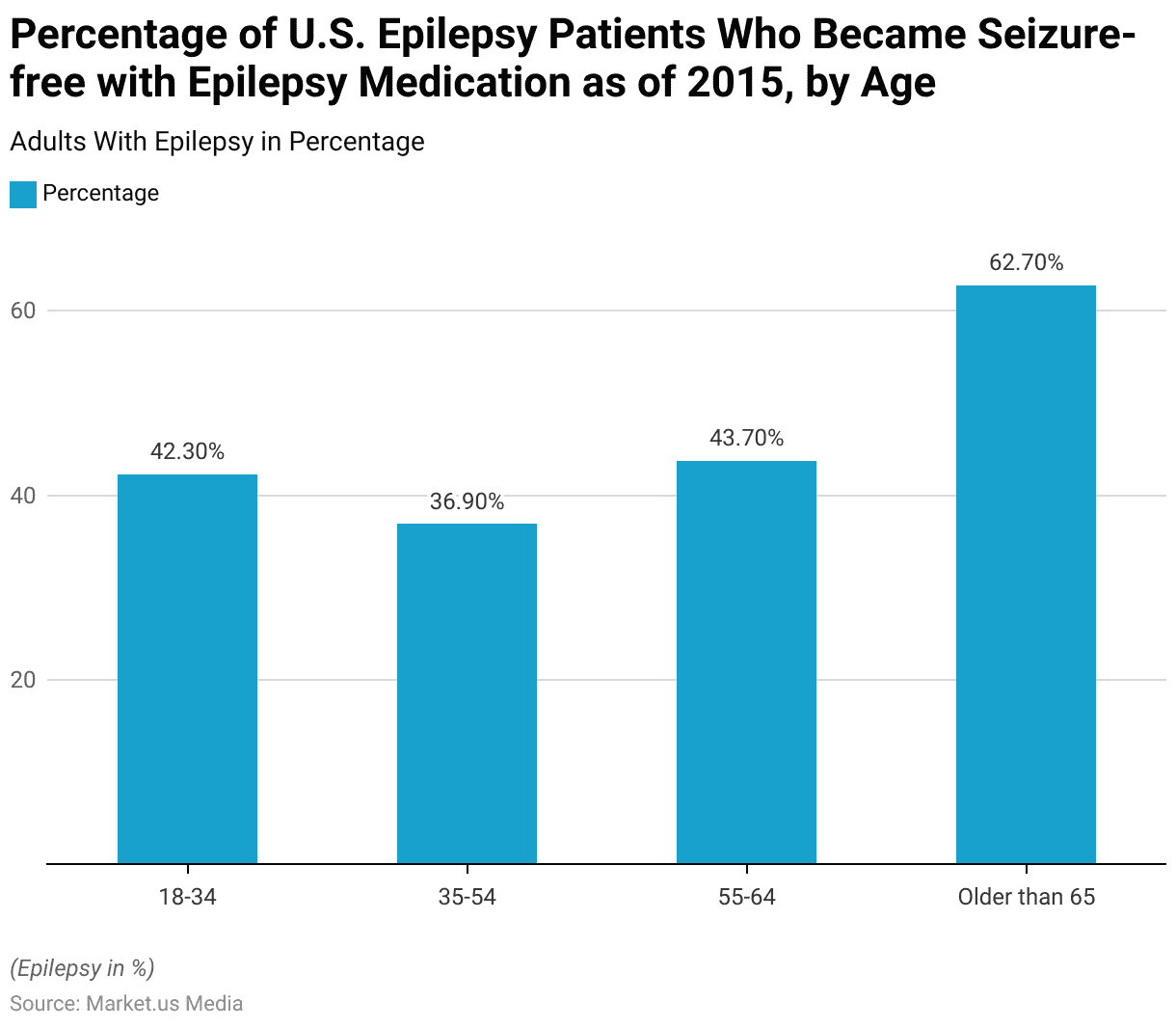
By Gender
- As of 2015, the effectiveness of epilepsy medication in achieving seizure-free status among U.S. adults showed minimal variation between genders.
- Among men with epilepsy, 43.70% reported becoming seizure-free with the use of medication.
- Similarly, 43.50% of women with epilepsy achieved seizure-free status through medication.

Cost of Epilepsy Medications
- The pricing of various antiepileptic medications varies significantly between brand-name and generic versions.
- For instance, Aptiom, a brand-name eslicarbazepine acetate, costs $1,010.09 for thirty 400-mg tablets, while no generic alternative exists.
- In contrast, generic carbamazepine costs $34.94 for sixty 200-mg tablets, significantly cheaper than brand-name Carbatrol at $113.32.
- Valproic acid, marketed as Depakene and Depakote, costs $450.30 and $579.50, respectively, for ninety tablets of different strengths, whereas generic versions are priced at $16.77 for the same quantity.
- Brand-name medications like Fycompa and Aptiom lack generic alternatives, leading to higher costs, such as $3,985.56 for 120 tablets of Fycompa.
- Conversely, generic alternatives like levetiracetam cost $9 for sixty tablets, providing more affordable options for patients and healthcare providers alike.
Price Trends
- According to a recent University of Michigan study published in Neurology, the cost of brand-name drugs for epilepsy covered by Medicare surged by 277% from 2010 to 2018.
- In contrast, during the same period, Medicare expenditures on generic epilepsy drugs declined by 42%.
- The study analyzed data from a 20% random sample of Medicare beneficiaries, ranging from 2008 to 2018, comprising between 77,000 to 133,000 individuals with epilepsy annually.
- Over this decade, annual per-patient costs for brand-name epilepsy medications rose sharply from $2,800 to $10,700, while costs for generic drugs decreased from $800 to $460.
- The increase in prescriptions for lacosamide contributed significantly to the rise in brand-name drug costs, accounting for 45% of the total increase.
Initiatives for the Development of Anti Epilepsy Medications
- Several initiatives are underway to advance the development of antiepileptic medications.
- The Epilepsy Foundation’s Epilepsy Pipeline Tracker is a prominent program that monitors the progress of new therapies, including drugs, devices, and treatments for epilepsy, thereby accelerating the development and approval process.
- Additionally, the organization supports research through grants and collaborations aimed at discovering innovative treatments for epilepsy and seizures.
- CURE Epilepsy is another key player, funding projects that explore cutting-edge approaches like implantable devices, which offer hope for those with treatment-resistant epilepsy.
Investments in the Development of Anti Epilepsy Medications
- Investments in the development of anti-epilepsy medications are significant and growing.
- In 2024, the UK government announced a £45 million investment in research for epilepsy, cancer, and dementia, which aims to accelerate the development of new treatments.
- Additionally, companies like Marinus Pharmaceuticals, Xenon Pharmaceuticals, Cerevel Therapeutics, and Stoke Therapeutics are heavily investing in innovative drugs.
- Marinus has invested millions in Ganaxolone, which targets rare pediatric epilepsy.
Research for Anti Epilepsy Medications and Treatments
- Recent advancements in the treatment of epilepsy have focused on innovative drug therapies and novel surgical approaches aimed at improving outcomes for patients with drug-resistant forms of the condition.
- Notably, research from Stanford Medicine has identified the fasciola cinereum, a previously overlooked region of the hippocampus, as a crucial area involved in seizure activity.
- This discovery suggests that targeting this region could enhance surgical planning and treatment effectiveness for those unresponsive to traditional surgery.
- Additionally, new medications such as XEN1101, a potassium channel opener, have shown promise in clinical trials, offering relief to patients with focal epilepsy.
Initiatives to Raise Awareness Against Epilepsy
- Several initiatives have been launched globally to raise awareness about epilepsy, focusing on education, stigma reduction, and support for those affected.
- The World Health Organization (WHO) and the International Bureau for Epilepsy (IBE) spearheaded the Intersectoral Global Action Plan on Epilepsy (IGAP), aiming to improve care and reduce stigma.
- Key activities include the “50 Million Steps for Epilepsy” campaign, encouraging people to walk steps symbolically representing the 50 million people living with epilepsy, thereby raising awareness and funds.
- Additionally, International Epilepsy Day, celebrated annually on the second Monday of February, involves various events like webinars, educational activities, and public engagements to promote understanding and support.
Regulations for Anti Epilepsy Medications and Treatments
- Regulations for anti-epilepsy medications and treatments vary by country, reflecting local healthcare policies and safety considerations.
- In the United States, the FDA requires stringent clinical trials and post-marketing surveillance to ensure the safety and efficacy of antiepileptic drugs (AEDs).
- In the UK, the Medicines and Healthcare Products Regulatory Agency (MHRA) enforces guidelines restricting the use of certain medications, such as sodium valproate, especially in women of childbearing age, unless no alternative is suitable due to risks to the fetus.
- In Australia, the Therapeutic Goods Administration (TGA) mandates comprehensive labelling and risk management plans for AEDs.
- European countries generally follow EMA guidelines, which emphasize patient safety and the need for risk minimization strategies, particularly regarding the use of AEDs during pregnancy.
Discuss your needs with our analyst
Please share your requirements with more details so our analyst can check if they can solve your problem(s)



